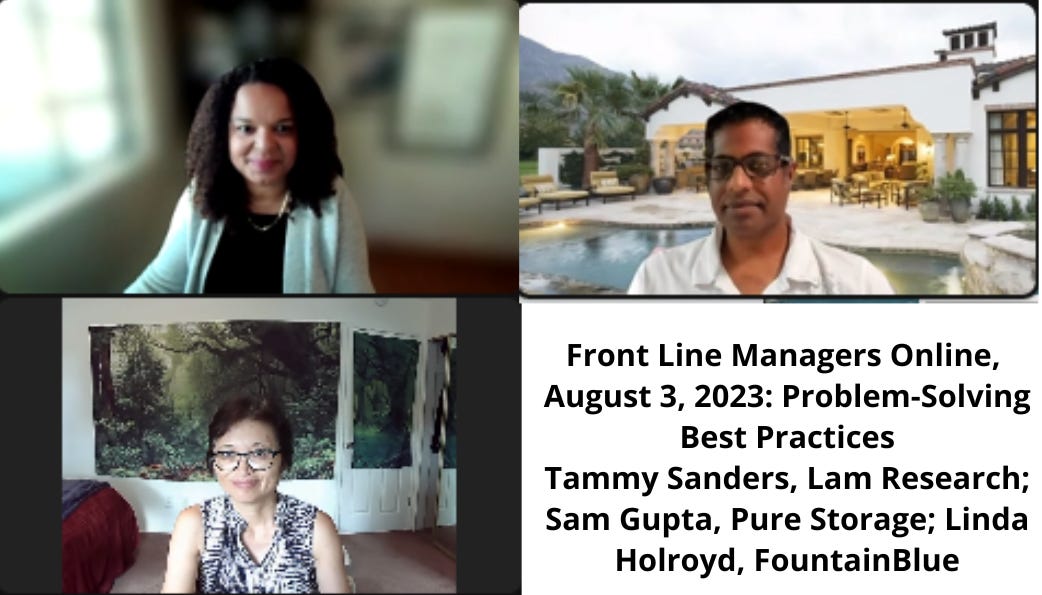FountainBlue's August 3 Front Line Managers Online program was on the topic of 'Problem-Solving Best Practices'. Please join me in thanking our panelists.
as a Product Leader - Sam Gupta, Pure Storage
as a People Leader - Tammy Sanders, Lam Research
Our inspiring and experienced panelists spoke eloquently and passionately about problem-solving best practices. Although they varied in their educational backgrounds and professional experience, they had much in common.
They valued short term requirements but also take a longer-term view.
They weave between the people, process, and technology requirements to bring together leaders at all levels in order to achieve measurable outcomes.
They courageously raise the bar and speak eloquently and succinctly to corporate requirements, value, and mandates to help ensure value is added for internal and external customers and partners.
Below is a synopsis of their advice and remarks.
Be Leader-ly
Be open-minded, vulnerable and authentic as a leader, and empower and engage the team to contribute to the problem-solving strategy, planning and execution.
Listen not just to the loudest voice in the room, but also to the collective community, the larger group, including those who are quiet and may represent the majority viewpoint, or a novel way of looking at a problem, or an interesting approach to solving a problem.
Err on the side of inclusivity, embracing opportunities for diverse perspectives. Rise even above equality (the intent to invite all to participate), but on to equity, where you make it easier for all to participate despite physical, emotional, mental and other differences.
Accept that you are human and manage your own energy level, your personal desires and motivations as you also manage and oversee the needs of the team and the needs of the individuals.
Be Strategic
Problem-Solving requires proactive and conscious planning, addressing the people, process, technology, and operational elements to optimize for results.
Don't choose to be a perfect problem-solver. Choose to Fail Fast rather than getting mired into a problem not worth solving. Choose to Fail Forward so that the attempts to solve a problem produce not-necessarily immediate results, but positive learnings and progressively incremental progress.
Prioritize the problems in front of you based on the impact to the customers you serve.
Look at a problem from the lens of the customer so that you better understand the needs, the motivations, the challenges, etc.,
Before requesting additional support and resources, make sure that the data speaks to the challenges and opportunities and succinctly report on what you've tried and what worked or didn't work. Then provide options for moving forward including additional funding, a strategic pivot, a collaboration opportunity, etc.,
As you work with many groups on a specific problem, be the translator between groups to help report on measurable progress and to help ensure alignment to corporate, team and product goals, mission and values.
As you work with global groups, support asynchronous communication tools so that teams around the world can document and inform without requiring real-time collaborations and connections 24x7.
Play the Long Game
Don't just solve for the short-term issue, but look also at the longer-term need to address the root cause of a problem. Make the longer-term plan to be more proficient, more sustainable, and more repeatable.
Make the longer-term objective expanded knowledge, increased inclusivity, leveled-one leadership rather than solving for just the problem in front of you today, which may come and go.
Build relationships with the wide range of stakeholders on an ongoing basis. Don't wait until you need to do an ask in order to solve a problem!
Build a community between stakeholders, reinforcing a culture which is open, inclusive, goal-oriented, and collaborative. They would be better positioned to address the problems of today and ones to come in the future.
Below is a list of problem-solving tools and strategies to consider:
The Ultimate Problem-Solving Process Guide: 31 Steps and Resources, Miles Anthony Smith, Jan 2022; See sample list below and full blog at https://www.initiativeone.com/post/problem-solving-process
Creative Inquiry
Appreciative Inquiry
Five Whys
Lean Six Sigma
Root Cause Analysis
Plan-Do-Check-Act
8D Problem-Solving
Army Problem-Solving Process
Productive Thinking Model
Identify, Define and Clarify the Issue
Produce Variety of Solution Options
Evaluate and Select Planned Fixes
Define Success
Evaluate, Monitor, Follow-Up
Collaborative Contingencies, Iteration, Course Correction
The Problem-Solving Process that Prevents GroupThink
An Innovator's Guide to Productive Thinking
Solving Problems with Your Problem-Solving
A Beginner's Guide to Problem-Solving
Our panelists agree that problem solving today is much more complex as we integrate geo-political, customer, team, organization, partner, and individual needs of our stakeholders. Adopting some of the best practices above and incrementally improving how we as leaders approach problem-solving will help enable and empower others to do the same.



